Source: QQ Unofficial site:
The Forbidden City (Zijincheng) (also known as the Imperial Palace (Gugong) and the Palace Museum) is the largest and best preserved collection of ancient buildings in China. The entrance to the Palace is through Tian'anmen gate. Once you reach Wumen (Meridian Gate) you enter the heart of the Complex and this is the place to buy your tickets.


After passing through Meridian gate, there is a huge Palace courtyard. Hereafter, the complex is divided into two sections: the Inner Court or the living quarters, and the working area also known as the Outer Court. The Palace courtyard contains the "stream of golden water" and five bridges, all decorated with carved torches, traditional symbols of masculinity. The Outer court is guarded by a row of lions protecting the Gate of Supreme Harmony.
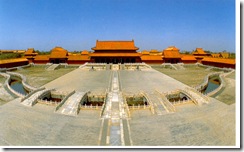

The Outer Court starts at the Hall of Supreme Harmony, the greatest and largest of all the halls in the complex. This was the most important building for the emperor and the place where all official business was done. Ceremonies such as the enthronement of the Crown Prince, the Emperor's birthday, imperial marriage ceremonies, and the initiation of military expeditions all took place here. The Emperor would arrive at the Hall of Supreme Harmony amidst ceremonial music, drum-beating and firecrackers. He would then take his place on the throne and listen to a reading of congratulatory messages from his palace courtiers. Civil and military officials would all kneel before him proclaiming, "Long Live Your Majesty." The building itself is decorated with thousands of dragons, the traditional symbol of the Emperor's power.
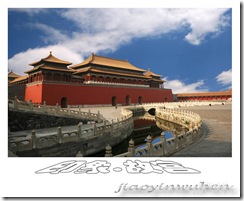
The Midway Hall of Harmony is a smaller hall where the emperor would prepare for the ceremonies to be held in the Hall of Supreme Harmony. The Midway hall was also used by the Emperor to examine agricultural instruments and discuss techniques. This was an important duty as the responsibility for a poor harvest fell largely on his shoulders.

The Inner Court begins at the Hall of Celestial Purity. The inner court was where the emperor, his concubines and Eunuchs lived. Approximately half of the six thousand people at the Imperial court were Eunuchs. Eunuchs were seen to improve the emperors position and ensured that his children were just that, HIS own! There were similar numbers of Concubines in the Palace. In this way, any aspiring courtiers or women who fancied they may rise up the social ladder a little were taken care of! The Emperor was definitely THE BOSS.
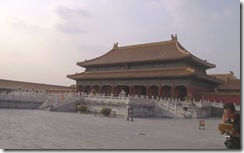
The Gate of Celestial Purity was where the emperor attended to state affairs. The Emperors Kangxi, Yongzheng and Qianlong attended to business here on a daily basis. After these three emperors died, standards fell and by the time the Qing dynasty came to power in 1644, corruption was rife.


During the Ming Dynasty and the early Qing Dynasty, the emperors lived in the Hall of Celestial Purity while the Empresses inhabited the Hall of Earthly Peace. The Hall of Union and Peace was the area where the emperor and empress could live together. In later periods, the Emperor and Empress moved to the Six West Palaces. The Emperor's choice of a son to succeed him is said to be kept in a secret box in the Hall of Celestial purity.
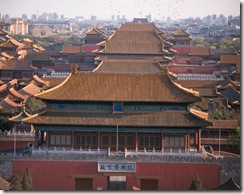
Legend has it that during the Ming Dynasty, two concubines tried to kill the Emperor with a rope. As they were very nervous, they accidentally tied a quick release knot. Another courtier watching brought help and the quick release knot was enough to save the Emperor from death. The women involved in the assassination plot were killed and their bodies dismembered and displayed as a lesson to any other would be troublemakers!

The Hall of Prolonged Happiness is known for the Western style crystal palace contained within the Hall. After the original Hall was destroyed by fire, the Emperor Xuntong began constructing a fireproof palace made from white marble and glass in its place. When the palace was half completed, the Qing Dynasty was overthrown and the project stopped.

South of here is the Yuqing Palace, the Palace for fasting. The Emperors were expected to fast the night before they offered sacrifices to Heaven. As a general rule, the emperors stayed here for the first two days of their fast and then moved to an imperial residence within the confines of the Temple of Heaven. During the fast the emperors abstained from wine, onions, garlic, chives, praying, involvement in petty affairs and making love. It must have been quite a task for them!

Emperor Qianlong built the Hall of Peaceful Longevity and made it into a Palace for the Emperor Dowager. Each year, on New Years day of the lunar calendar, the emperor would entertain ministers in this pavilion. Cups filled with wine would be placed on the water in the lake of the gardens. If the floating cup stopped in front of you, you were asked to drink the wine and make a poem!
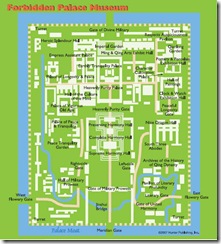
The best way to approach a trip to the Forbidden City is to first examine it in detail, either with an audio tape or some reference and then to double back on yourself and just enjoy wandering and imagining what life must have been like there. In order to fully appreciate the majesty of the Forbidden City, try to allow at least half a day for the visit.
You can take bus No.1,4,52,103,111 to get there.
Ticket Price: RMB40 in the off-season (from Nov.1 to Mar.31), while RMB60 in the peak season (from April.1 to Oct.31).
Opening Time: 8:30--16:30 from Oct.16 to April 31. Latest time for ticket purchase: 15:30 8:30--17:00 from April.16 to Oct.15. Latest time for ticket purchase: 16:00
Note: The prime area for sightseeing is the center area of the Imperial Palace, however if time permits, you could also have a walk and visit the west areas.

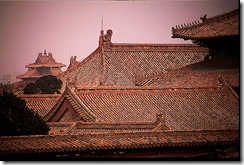


theFundooGeek recommended reading :
Note: the pictures are the copyright of their respectful owners.



 Newer Post
Newer Post
 Home
Home







Comments :
0 comments to “The Forbidden Palace In China (Amazing Pics)”
Post a Comment